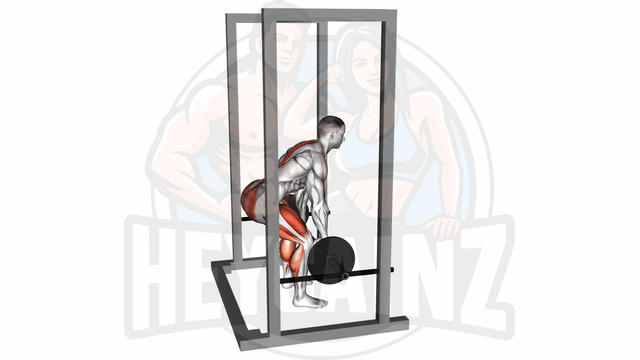
Instructions:
- 1Position your barbell on a rack at knee level
- 2Stand in front of the barbell with a hip-width stance
- 3Bend and grip the bar, ensuring your back is straight and knees slightly bent
- 4Pull up the barbell by extending your hips and knees to a full stand
- 5Lower the barbell back down to the rack in a controlled manner
Tips:
- Keep your back flat throughout the exercise
- Remember not to lift with your back, the power should come from your legs and hips
- Breathe out as you lift the barbell and breathe in as you lower it
- Maintain a braced core to support your lower back
Mastering the Barbell Rack Pull: A Comprehensive Guide
The Barbell Rack Pull is an excellent exercise for building strength and muscle in the hips, particularly targeting the Erector Spinae and Gluteus Maximus. As a variation of the deadlift, the rack pull emphasizes lifting from an elevated position, making it a great choice for individuals looking to enhance their strength and overall performance.
To perform the barbell rack pull correctly, begin by setting the barbell at an appropriate height on a squat rack or similar platform, typically around knee level or slightly above. This setup allows for a greater focus on the hip hinge, helping to develop explosiveness and power in the posterior chain without the full range of motion required in classic deadlifts.
Muscles Worked
During the barbell rack pull, the primary muscles engaged include:
- Erector Spinae: Critical for maintaining spinal integrity and stability.
- Gluteus Maximus: A key muscle for hip extension and power generation.
Tips for Success
- Proper Setup: Ensure that the bar is positioned securely on the rack to prevent it from rolling or falling during the lift.
- Foot Position: Keep your feet shoulder-width apart and your shins close to the bar to maximize leverage.
- Grip Choice: Utilize either a double overhand grip or a mixed grip for better control of the barbell.
- Focus on Form: Maintain a neutral spine throughout the lift, engaging your core to protect your lower back.
- Controlled Movements: Lift explosively but lower the bar in a controlled manner to enhance muscle engagement.
Barbell Rack Pull Alternatives
If you’re looking to diversify your routine, consider trying some alternatives to the barbell rack pull:
- Barbell Deadlift: A classic exercise that also emphasizes the posterior chain but with a different approach.
- Smith Machine Rack Pull: Using a Smith machine can provide additional stability and safety while performing the lift.
In conclusion, the barbell rack pull is a vital exercise that can significantly enhance strength and muscle definition in the hips and lower back. By incorporating this exercise along with its alternatives into your fitness regimen, you can achieve remarkable results in your strength training journey.